您好,登錄后才能下訂單哦!
您好,登錄后才能下訂單哦!
這篇文章將為大家詳細講解有關Java中流怎么用,小編覺得挺實用的,因此分享給大家做個參考,希望大家閱讀完這篇文章后可以有所收獲。
1.File類的一個對象,代表一個文件或一個文件目錄(俗稱:文件夾)
2.File了聲明在java.io包下
3.File類中涉及到關于文件或文件目錄的創建、刪除、重命名、修改時間、文件大小等方法。
并涉及到寫入或讀取文件內容的操作。入宮需要讀取或寫入文件內容,必須使用IO流來完成。
4.后續File類的對象常會作為參數傳遞到流的構造器中,指明讀取或寫入的"終點"。
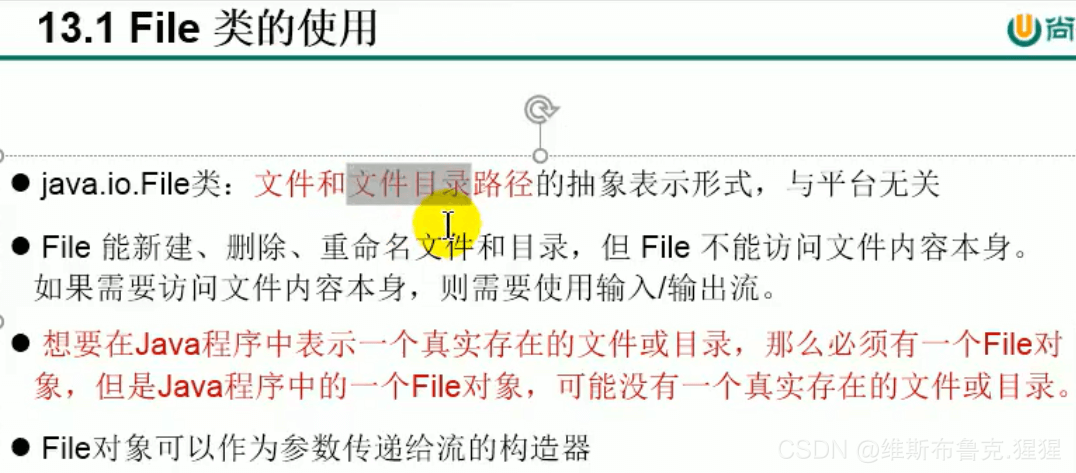
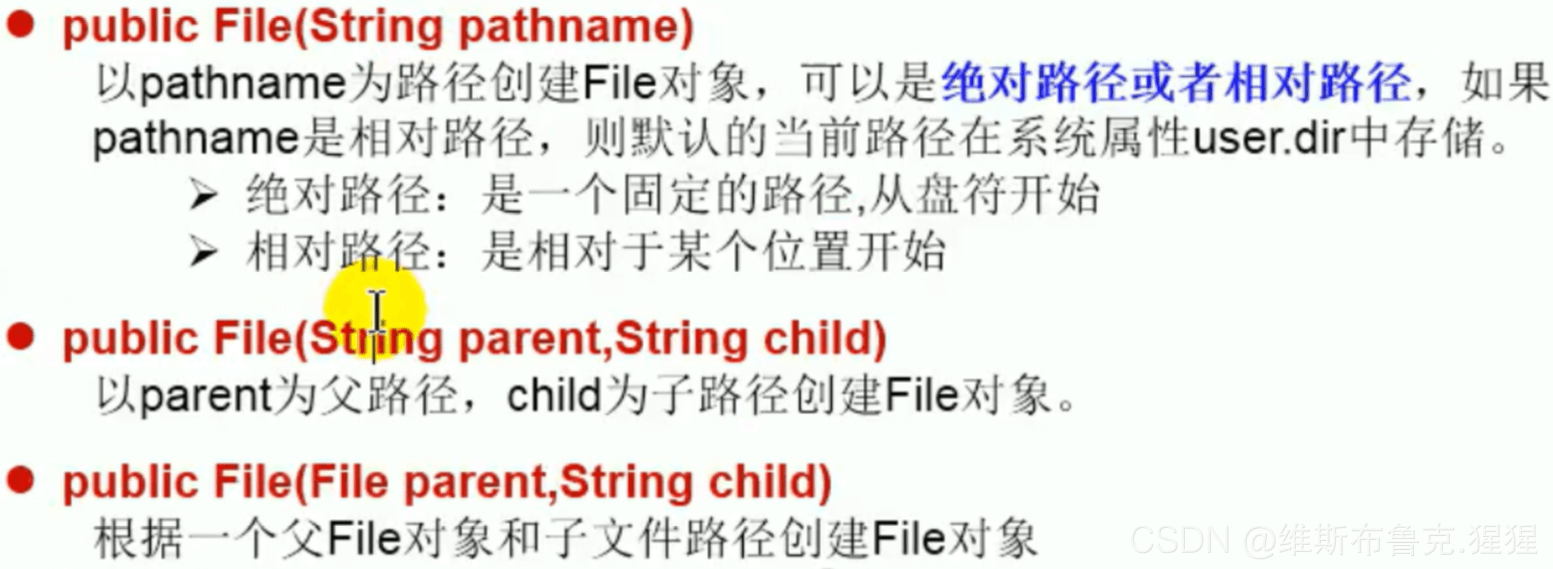
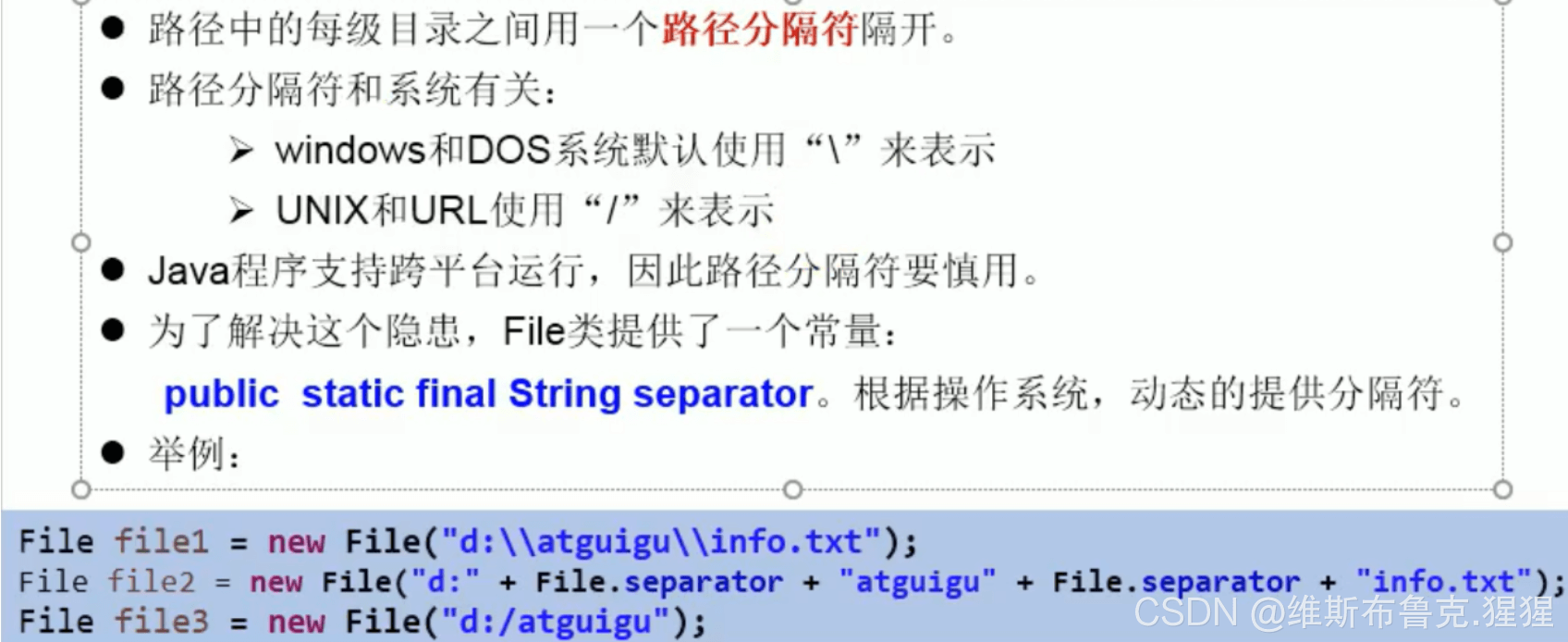
/*
1.如何創建File類的實例
File(String filePath)
File(String parentPath,String,childPath)
File(File parentFile,String childPath)
2.相對路徑:相較于某個路徑下,知名的路徑。
絕對路徑:包含盤符在內的未見或文件目錄的路徑
3.路徑分隔符
windows:\\
unix:/
*/
public void test1() {
//構造器1
File file1 = new File("hello.txt");//相對于module
File file2 = new File("E:\\zxdym\\IDEA\\code\\JavaSenior\\2021_08\\he.txt");
System.out.println(file1);
System.out.println(file2);
//構造器2
File file3 = new File("E:\\zxdym\\IDEA\\code", "JavaSenior");
System.out.println(file3);
//構造器3
File file4 = new File(file3, "hi.txt");
System.out.println(file4);
}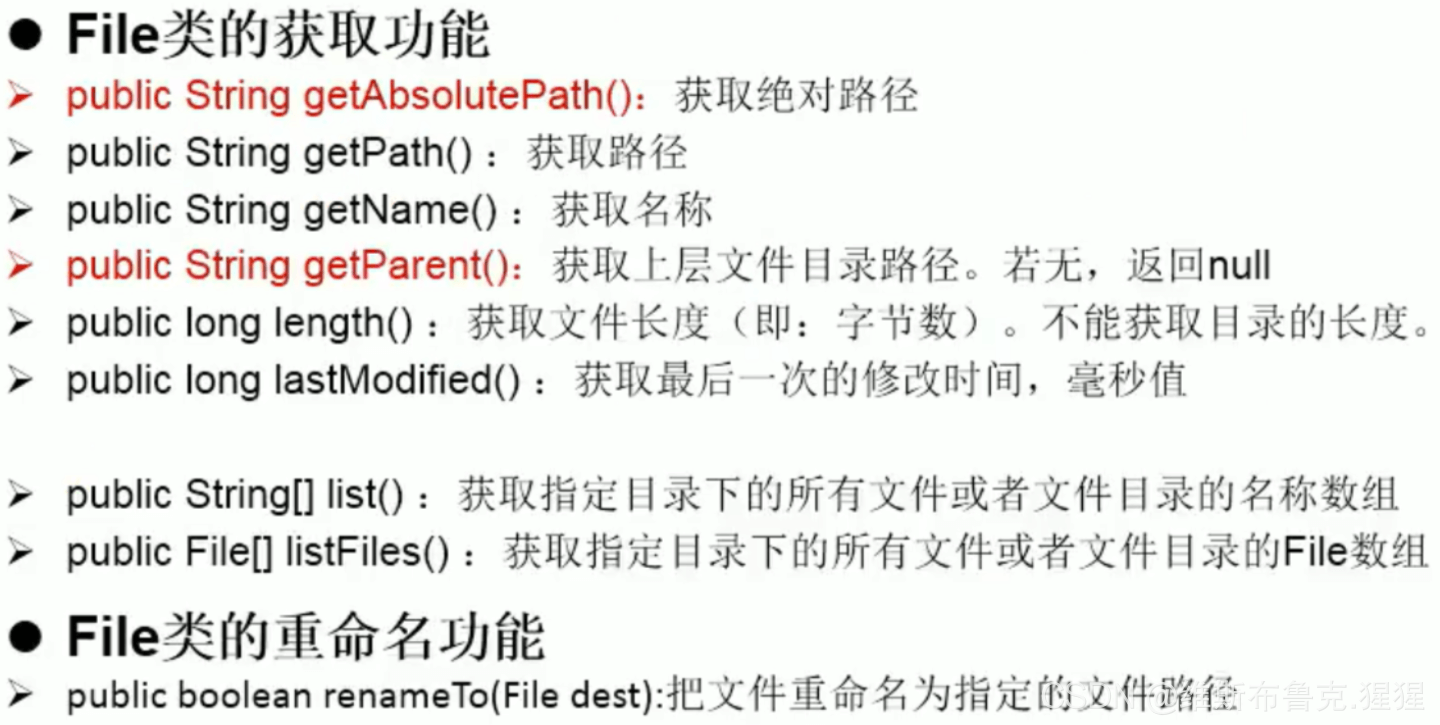
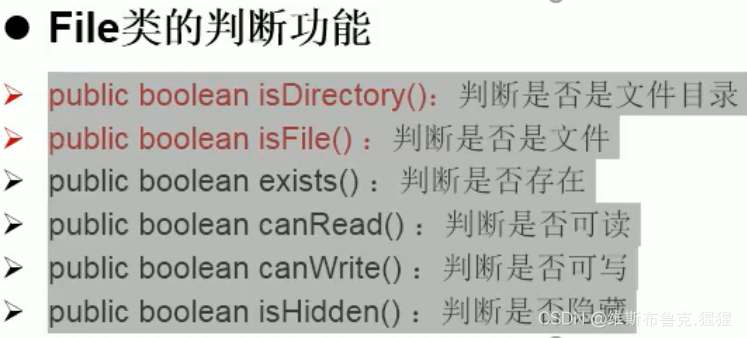
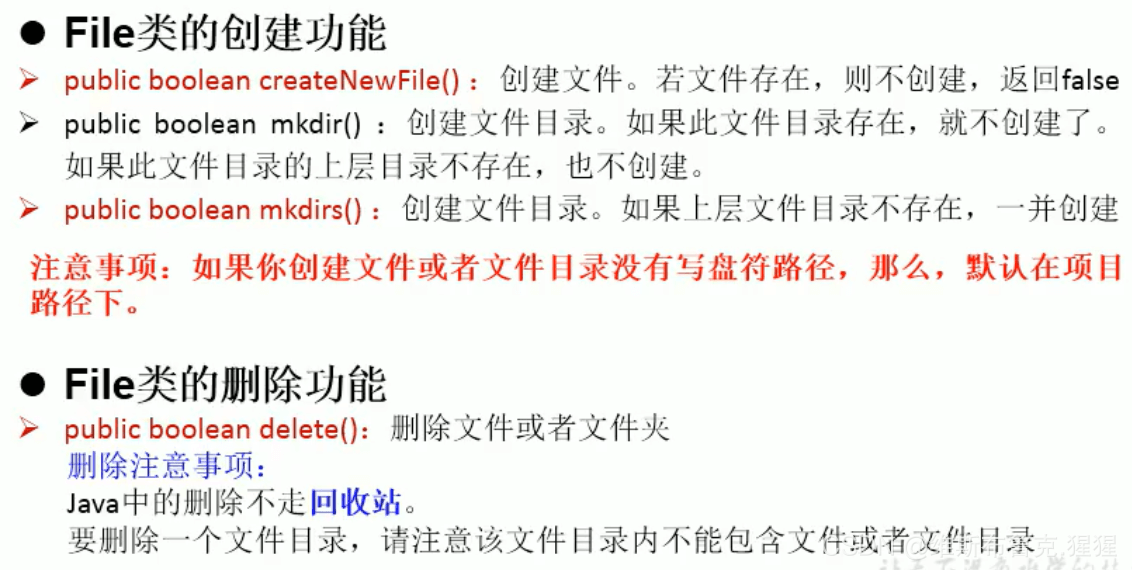
public void test2() {
File file1 = new File("hello.txt");
File file2 = new File("d:\\io\\hi.txt");
System.out.println(file1.getAbsolutePath());
System.out.println(file1.getPath());
System.out.println(file1.getName());
System.out.println(file1.getParent());
System.out.println(file1.length());
System.out.println(new Date(file1.lastModified()));
System.out.println();
System.out.println(file2.getAbsolutePath());
System.out.println(file2.getPath());
System.out.println(file2.getName());
System.out.println(file2.getParent());
System.out.println(file2.length());
System.out.println(file2.lastModified());
}
public void test3() {
File file = new File("E:\\\\zxdym\\\\IDEA\\\\code\\\\JavaSenior");
String[] list = file.list();
for (String s : list) {
System.out.println(s);
}
System.out.println();
File[] files = file.listFiles();
for (File f : files) {
System.out.println(f);
}
}
/*
public boolean removeTo(File dest):把文件重命名為指定的文件路徑
比如:file1.renameTo(file2)為例:
要想保證返回true,需要file1在硬盤中是存在的,且file2不能在硬盤中存在。
*/
@Test
public void test4() {
File file1 = new File("hello.txt");
File file2 = new File("D:\\io\\hi.txt");
boolean renameTo = file1.renameTo(file2);
System.out.println(renameTo);
}
@Test
public void test5() {
File file1 = new File("hello.txt");
System.out.println(file1.isDirectory());
System.out.println(file1.isFile());
System.out.println(file1.exists());
System.out.println(file1.canRead());
System.out.println(file1.canWrite());
System.out.println(file1.isHidden());
}
@Test
public void test6() throws IOException {
File file1 = new File("hi.txt");
if (!file1.exists()) {
file1.createNewFile();
System.out.println("創建成功");
} else {//文件存在
file1.delete();
System.out.println("刪除成功");
}
}
@Test
public void test7(){
//文件目錄的創建
File file1 = new File("e:\\io\\io1\\io3");
boolean mkdir = file1.mkdir();
if(mkdir){
System.out.println("創建成功1");
}
File file2 = new File("e:\\io\\io1\\io3");
boolean mkdir1 = file1.mkdirs();
if(mkdir1){
System.out.println("創建成功2");
}
}D.注意點
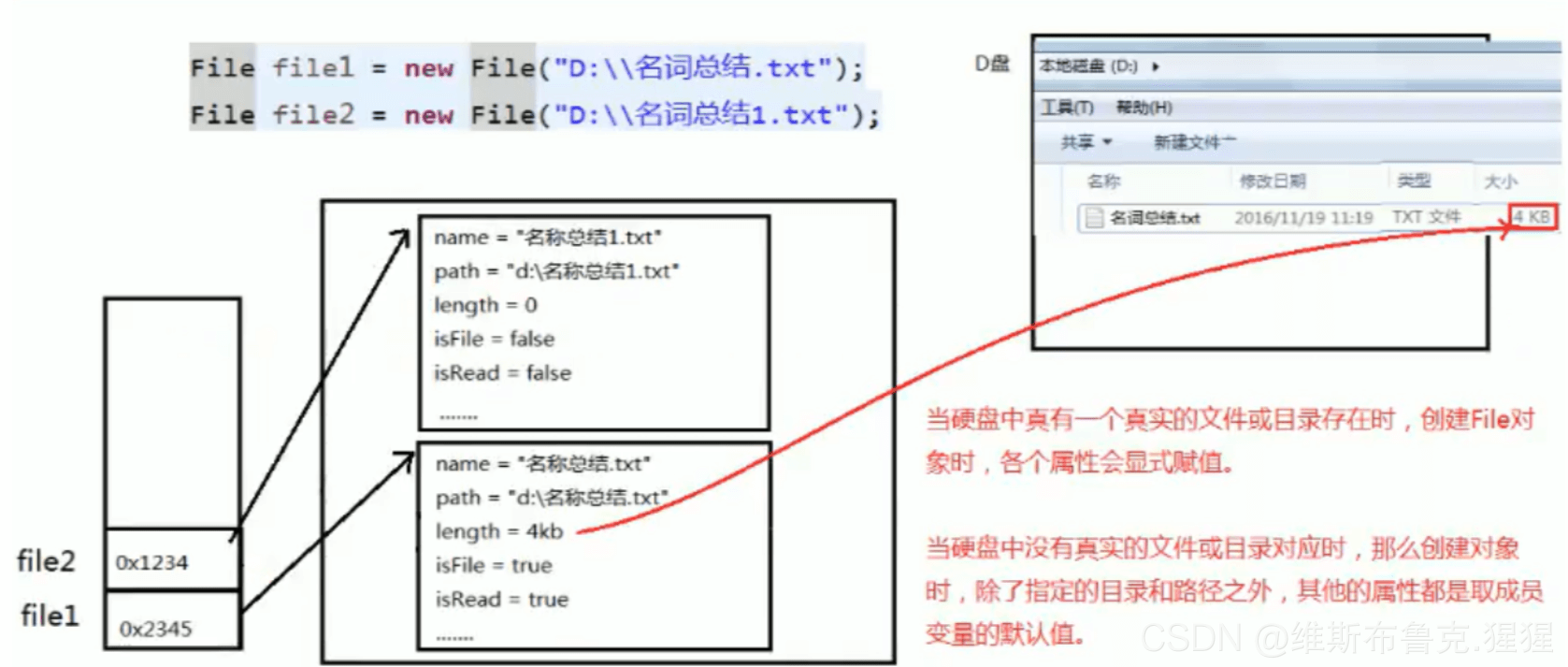
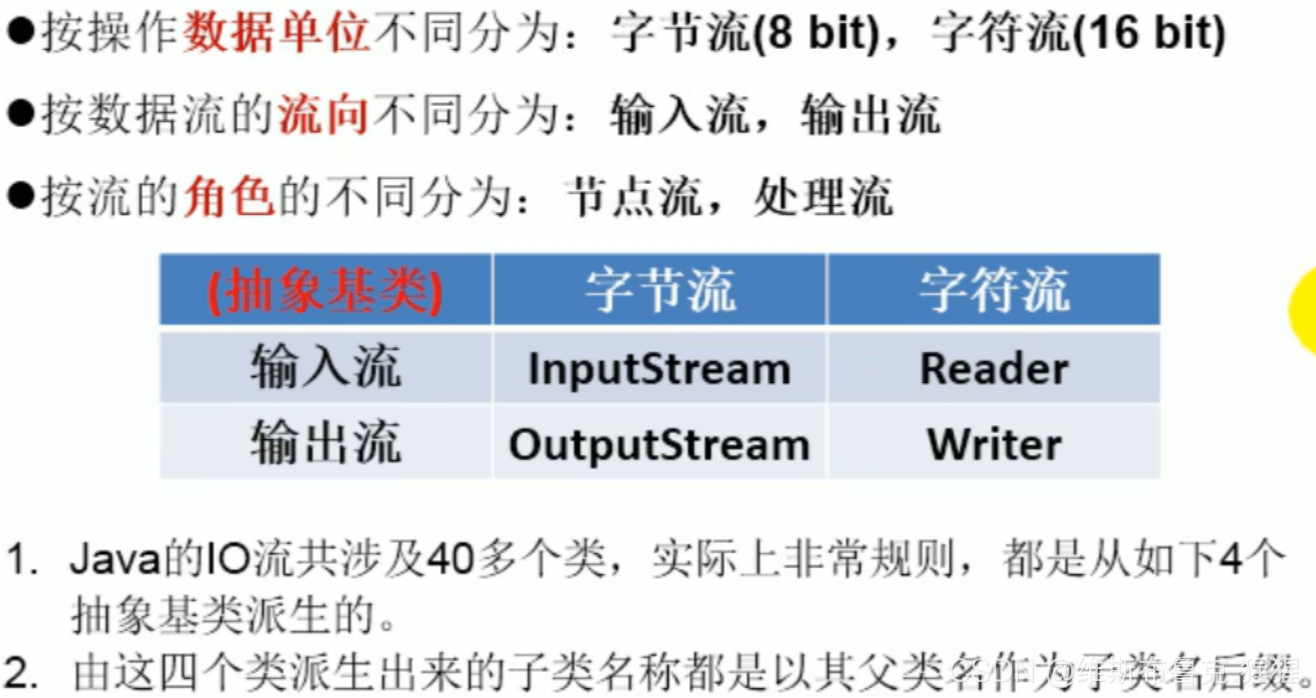
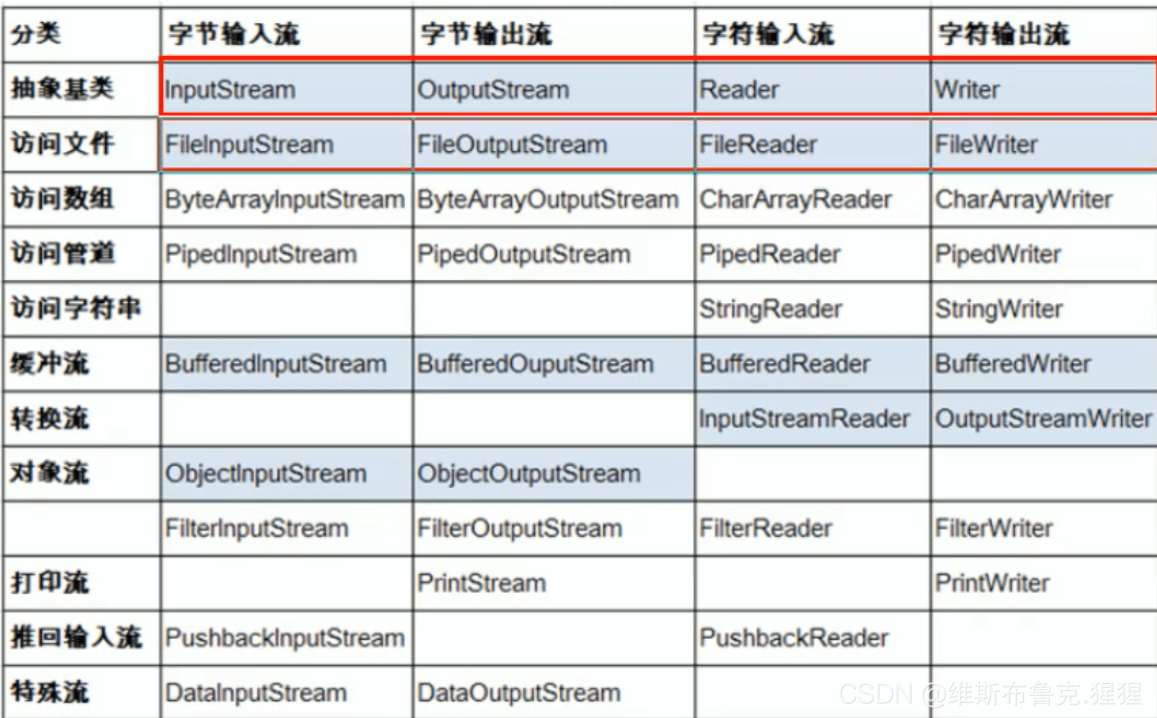
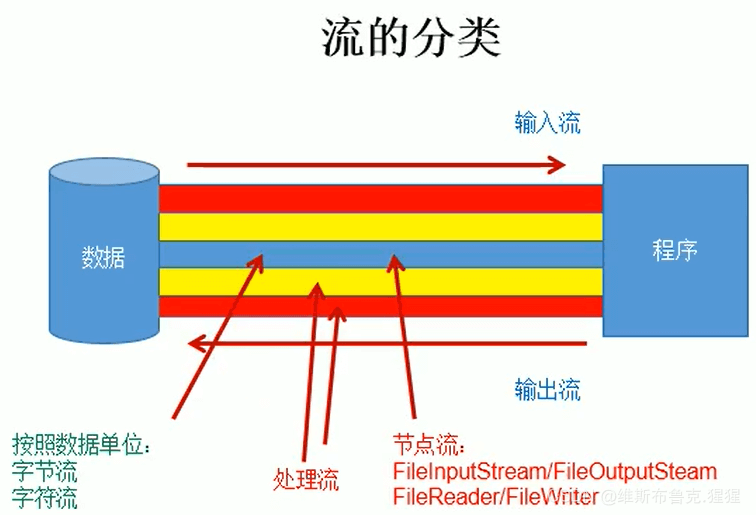
開發中,用緩沖流,效率比節點流高(藍色框中的表示重要的、常用的)
A.創建File類的對象,指明讀取的數據的來源。(要求此文件一定要存在)
B.創建相應的輸入流,將File類的對象作為參數,傳入流的構造器中
C.具體的讀入過程:
創建相應的byte[] 或 char[]
D.關閉流資源
說明:程序中出現的異常需要使用try-catch-finally處理。
A.創建File類的對象,指明寫出的數據的來源。(要求此文件一定要存在)
B.創建相應的輸出流,將File類的對象作為參數,傳入流的構造器中
C.具體的寫出過程:
write(char[]/byte[] buffer,0,len)
D.關閉流資源
說明:程序中出現的異常需要使用try-catch-finally處理。
public class FileReaderWriterTest {
public static void main(String[] args) {
File file = new File("hello.txt");//相較于前工程
System.out.println(file.getAbsolutePath());
File file1 = new File("2021_08\\hello.txt");
System.out.println(file1.getAbsolutePath());
}
/*
將day09下的hello.txt文件內容讀入程序中,并輸出到控制臺
說明點:
1.read()的理解,返回讀入的一個字符,如果達到文件末尾,返回-1
2.異常的處理:為了保證流資源一定可以執行關閉操作。需要使用try-catch-finally處理
3.讀入的文件一定要存在,否則就會報FileNotFoundException.
*/
@Test
public void testFileReader(){
FileReader fr = null;
try {
//1.實例化File類的對象,指明要操作的文件
File file = new File("hello.txt");//相較于當前Module
//2.提供具體的流
fr = new FileReader(file);
//3.數據的讀入
//read():返回讀入的一個字符,如果達到文件末尾,返回-1
//方式一:
// int data = fr.read();
// while(data != -1){
// System.out.print((char)data);
// data = fr.read();
// }
//方式二:語法上針對方式一的修改
int data;
while((data = fr.read()) != -1){
System.out.print((char)data);
}
} catch (IOException e) {
e.printStackTrace();
} finally {
//4.流的關閉操作
try {
if(fr != null)
fr.close();
} catch (IOException e) {
e.printStackTrace();
} finally {
}
}
}
@Test
public void testFileReader1(){
FileReader fr = null;
try {
//1.File類的實例化
File file = new File("hello.txt");
//2.FileReader流的實例化
fr = new FileReader(file);
//3.讀入的操作
//read(char[] cbuf):返回每次讀入cbuf數組中的字符的個數,如果達到文件末尾,返回-1
char[] cbuf = new char[5];
int len;
while(( len = fr.read(cbuf)) != -1){
//方式一:
//錯誤的寫法//知識點難點:數組元素的覆蓋
// for(int i = 0;i < cbuf.length;i++){
// System.out.print(cbuf[i]);
// }
//正確的寫法
// for(int i = 0;i < len;i++){
// System.out.print(cbuf[i]);
// }
//方式二:
//錯誤的寫法,對應著方式一的錯誤的寫法
// String str = new String(cbuf);
// System.out.println(str);
//正確的寫法
String str = new String(cbuf, 0, len);
System.out.print(str);
}
} catch (IOException e) {
e.printStackTrace();
} finally {
if(fr != null){
//4.資源的關閉
try {
fr.close();
} catch (IOException e) {
e.printStackTrace();
}
}
}
}
/*
從內存中寫出數據到硬盤的文件里
說明:
1.輸出操作,對應的File可以不存在的,并不會報異常
2.
File對應的硬盤中的文件如果不存在,在輸出的過程中,會自動創建此文件
File對應的硬盤中的文件如果存在:
如果流使用的構造器是:FileWriter(file,false) / FileWriter(file):對原有文件的覆蓋
如果流使用的構造器是:FileWriter(file,true):不會對原有文件覆蓋,而是在原有文件基礎上追加內容
*/
@Test
public void testFileWriter() {
FileWriter fw = null;
try {
//1.提供File類的對象,指明寫出到的文件
File file = new File("hello1.txt");
//2.提供FileWriter的對象,用于數據的寫出
fw = new FileWriter(file,false);
//3.寫出的操作
fw.write("I have a dream!\n");
fw.write("you need to have a dream!");
} catch (IOException e) {
e.printStackTrace();
} finally {
//4.流資源的關閉
if(fw != null){
try {
fw.close();
} catch (IOException e) {
e.printStackTrace();
}
}
}
}
@Test
public void testFileReaderFileWriter(){
FileReader fr = null;
FileWriter fw = null;
try {
//1.創建File類的對象,指明讀入和寫出的文件
File srcFile = new File("hello.txt");
File destFile = new File("hello2.txt");
//不能使用字符流來處理圖片等字節數據
// File srcFile = new File("愛情與友情.jpg");
File destFile = new File("愛情與友情1.jpg");
//2.創建數據入流和輸出流的對象
fr = new FileReader(srcFile);
fw = new FileWriter(destFile);
//3.數據的讀入和寫出操作
char[] cbuf = new char[5];
int len;//記錄每次讀入到cbuf數組中的字符的個數
while((len = fr.read(cbuf)) != -1){
//每次寫出len個字符
fw.write(cbuf,0,len);
}
} catch (IOException e) {
e.printStackTrace();
} finally {
// //4.關閉流資源
// //方式一:
// try {
// fw.close();
// } catch (IOException e) {
// e.printStackTrace();
// }finally {
// try {
// fr.close();
// } catch (IOException e) {
// e.printStackTrace();
// }
// }
//方式二:
try {
fw.close();
} catch (IOException e) {
e.printStackTrace();
}
try {
fr.close();
} catch (IOException e) {
e.printStackTrace();
}
}
}
}測試FileInputStream和FileOutputStream的使用
public class FileInputOutputStreamTest {
//使用字節流FileInputOutputStream處理文本文件,可能出現亂碼
@Test
public void testFileInputStream(){
FileInputStream fis = null;
try {
//1.造文件
File file = new File("hello.txt");
//2.造流
fis = new FileInputStream(file);
//3.讀數據
byte[] buffer = new byte[5];
int len;//記錄每次讀取的字節的個數
while((len = fis.read(buffer)) != -1){
String str = new String(buffer, 0, len);
System.out.print(str);
}
} catch (IOException e) {
e.printStackTrace();
} finally {
//4.關閉資源
try {
fis.close();
} catch (IOException e) {
e.printStackTrace();
}
}
}
/*
實現對圖片的復制操作
*/
@Test
public void testFileInputOutputStream(){
FileInputStream fis = null;
FileOutputStream fos = null;
try {
File srcFile = new File("愛情與友情.jpg");
File destFile = new File("愛情與友情2.jpg");
fis = new FileInputStream(srcFile);
fos = new FileOutputStream(destFile);
//復制的過程
byte[] buffer = new byte[5];
int len;
while((len = fis.read(buffer)) != -1){
fos.write(buffer,0,len);
}
} catch (IOException e) {
e.printStackTrace();
} finally {
if(fos != null){
try {
fos.close();
} catch (IOException e) {
e.printStackTrace();
}
}
if(fis != null){
try {
fis.close();
} catch (IOException e) {
e.printStackTrace();
}
}
}
}
//指定路徑下文件的復制
public void copyFile(String srcPath,String destPath){
FileInputStream fis = null;
FileOutputStream fos = null;
try {
File srcFile = new File(srcPath);
File destFile = new File(destPath);
fis = new FileInputStream(srcFile);
fos = new FileOutputStream(destFile);
//復制的過程
byte[] buffer = new byte[5];
int len;
while((len = fis.read(buffer)) != -1){
fos.write(buffer,0,len);
}
} catch (IOException e) {
e.printStackTrace();
} finally {
if(fos != null){
try {
fos.close();
} catch (IOException e) {
e.printStackTrace();
}
}
if(fis != null){
try {
fis.close();
} catch (IOException e) {
e.printStackTrace();
}
}
}
}
@Test
public void testCopyFile(){
long start = System.currentTimeMillis();
String srcPath = "C:\\Users\\Administrator\\Desktop\\01-視頻.avi";
String destPath = "C:\\Users\\Administrator\\Desktop\\02-視頻.avi";
copyFile(srcPath,destPath);
long end = System.currentTimeMillis();
System.out.println("復制操作花費的時間為:" + (end - start));
}
}結論:
1.對于文本文件(.txt,.java,.c,.cpp),使用字符流處理
2.對于非文本文件(.jpg,.mp3,.mp4,.avi,.doc,.ppt,...),使用字節流處理
處理流之一:緩沖流的作用
1.緩沖流:
BufferedInputStream
BufferedOutputStream
BufferedReader
BufferedWriter
2.作用:提高流的讀取,寫入的速度
提高讀寫速度的原因:內部提供了一個緩沖區,默認情況是8kb
3.處理流:就是"套接"在已有流的基礎上
public class BufferedTest {
@Test
public void BufferedStreamTest(){
BufferedInputStream bis = null;
BufferedOutputStream bos = null;
try {
//1.造文件
File srcFile = new File("愛情與友情.jpg");
File destFile = new File("愛情與友情3.jpg");
//2.造流
//2.1造節點流
FileInputStream fis = new FileInputStream(srcFile);
FileOutputStream fos = new FileOutputStream(destFile);
//2.2造緩沖流
bis = new BufferedInputStream(fis);
bos = new BufferedOutputStream(fos);
//3.復制的細節:讀取、寫入
byte[] buffer = new byte[10];
int len;
while((len = bis.read(buffer)) != -1){
bos.write(buffer,0,len);
// bos.flush();//刷新緩沖區
}
} catch (IOException e) {
e.printStackTrace();
} finally {
//4.資源關閉
//要求:先關閉外層的流,再關閉內層的流
if(bos != null){
try {
bos.close();
} catch (IOException e) {
e.printStackTrace();
}
}
if(bis != null){
try {
bis.close();
} catch (IOException e) {
e.printStackTrace();
}
}
//說明:關閉外層流的同時,內層流也會自動的進行關閉,關于內層流的關閉,可以省略
// fos.close();
// fis.close();
}
}
@Test
public void testCopyFileWithBuffered(){
long start = System.currentTimeMillis();
String srcPath = "C:\\Users\\Administrator\\Desktop\\01-視頻.avi";
String destPath = "C:\\Users\\Administrator\\Desktop\\03-視頻.avi";
copyFileWithBuffered(srcPath,destPath);
long end = System.currentTimeMillis();
System.out.println("復制操作花費的時間為:" + (end - start));
}
//實現文件復制的方法
public void copyFileWithBuffered(String srcPath,String destPath) {
BufferedInputStream bis = null;
BufferedOutputStream bos = null;
try {
//1.造文件
File srcFile = new File(srcPath);
File destFile = new File(destPath);
//2.造流
//2.1造節點流
FileInputStream fis = new FileInputStream(srcFile);
FileOutputStream fos = new FileOutputStream(destFile);
//2.2造緩沖流
bis = new BufferedInputStream(fis);
bos = new BufferedOutputStream(fos);
//3.復制的細節:讀取、寫入
byte[] buffer = new byte[10];
int len;
while ((len = bis.read(buffer)) != -1) {
bos.write(buffer, 0, len);
}
} catch (IOException e) {
e.printStackTrace();
} finally {
//4.資源關閉
//要求:先關閉外層的流,再關閉內層的流
if (bos != null) {
try {
bos.close();
} catch (IOException e) {
e.printStackTrace();
}
}
if (bis != null) {
try {
bis.close();
} catch (IOException e) {
e.printStackTrace();
}
}
//說明:關閉外層流的同時,內層流也會自動的進行關閉,關于內層流的關閉,可以省略
// fos.close();
// fis.close();
}
}
/*
使用BufferedReader和BufferedWriter實現文本文件的復制
*/
@Test
public void testBufferedReaderBufferedWriter(){
BufferedReader br = null;
BufferedWriter bw = null;
try {
//創建文件和相應的流
br = new BufferedReader(new FileReader(new File("dpcp.txt")));
bw = new BufferedWriter(new FileWriter(new File("dpcp1.txt")));
//讀寫操作
//方式一:使用char[]數組
// char[] cbuf = new char[1024];
// int len;
// while((len = br.read(cbuf)) != -1){
// bw.write(cbuf,0,len);
// }
//方式二:使用String
String data;
while((data = br.readLine()) != null){
//方法一:
bw.write(data + "\n");//data中不包含換行符
//方法二:
bw.write(data);//data中不包含換行符
bw.newLine();//提供換行的操作
}
} catch (IOException e) {
e.printStackTrace();
} finally {
//關閉資源
if(bw != null){
try {
bw.close();
} catch (IOException e) {
e.printStackTrace();
}
}
if(br != null){
try {
br.close();
} catch (IOException e) {
e.printStackTrace();
}
}
}
}
}處理流之二:轉換流的使用(重點)
1.轉換流:屬于字符流
InputStreamReader:將一個字節的輸入流轉換為字符的輸入流
OutputStreamWriter:將一個字符的輸出流轉換為字節的輸出流
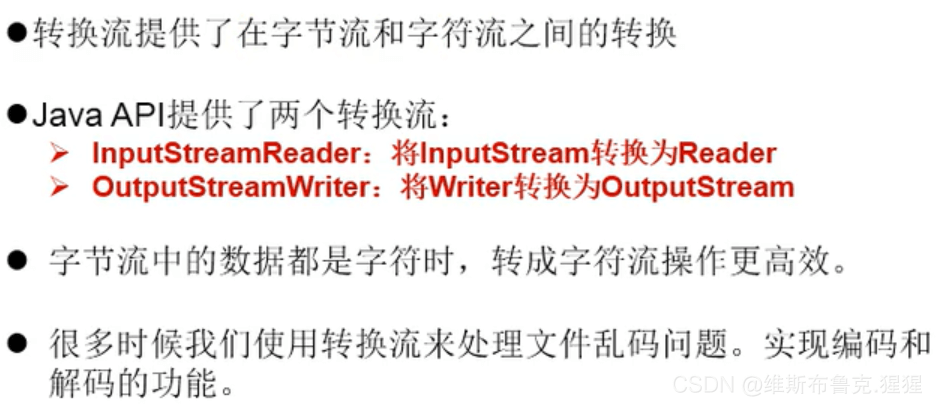
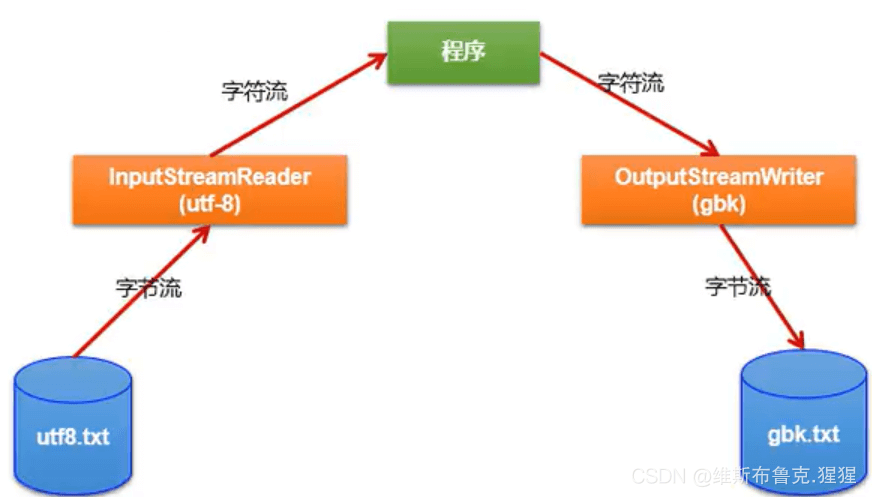
2.作用:提供字節流與字符流之間的轉換
3.解碼:字節、字節數組 ---> 字符數組、字符串
編碼:字符數組、字符串---> 字節、字節數組
說明:編碼決定了解碼的方式
4.字符集
說明:文件編碼的方式(比如:GBK),決定了解析時使用的字符集(也只能是GBK)
public class InputStreamReaderTest {
/*
此時處理異常的話,仍然應該使用try-catch-finally
*/
@Test
public void test1() throws IOException{
FileInputStream fis = new FileInputStream("dbcp.txt");
// InputStreamReader isr = new InputStreamReader(fis);//使用系統默認的字符集
//參數2指明了字符集,具體使用那個字符集,取決于文件dbcp.txt保存時使用的字符集
InputStreamReader isr = new InputStreamReader(fis, "UTF-8");
char[] cbuf = new char[20];
int len;
while((len = isr.read(cbuf)) != -1){
String str = new String(cbuf,0,len);
System.out.print(str);
}
isr.close();
}
/*
此時處理異常的話,仍然應該使用try-catch-finally
綜合使用InputStreamReader和OutputStreamWriter
*/
@Test
public void test2() throws Exception{
//1.造文件、造流
File file1 = new File("dbcp.txt");
File file2 = new File("dbcp_gbk.txt");
FileInputStream fis = new FileInputStream(file1);
FileOutputStream fos = new FileOutputStream(file2);
InputStreamReader isr = new InputStreamReader(fis, "UTF-8");
OutputStreamWriter osw = new OutputStreamWriter(fos, "gbk");
//2.讀寫過程
char[] cbuf = new char[20];
int len;
while((len = isr.read(cbuf)) != -1){
osw.write(cbuf,0,len);
}
//3.關閉資源
isr.close();
osw.close();
}
}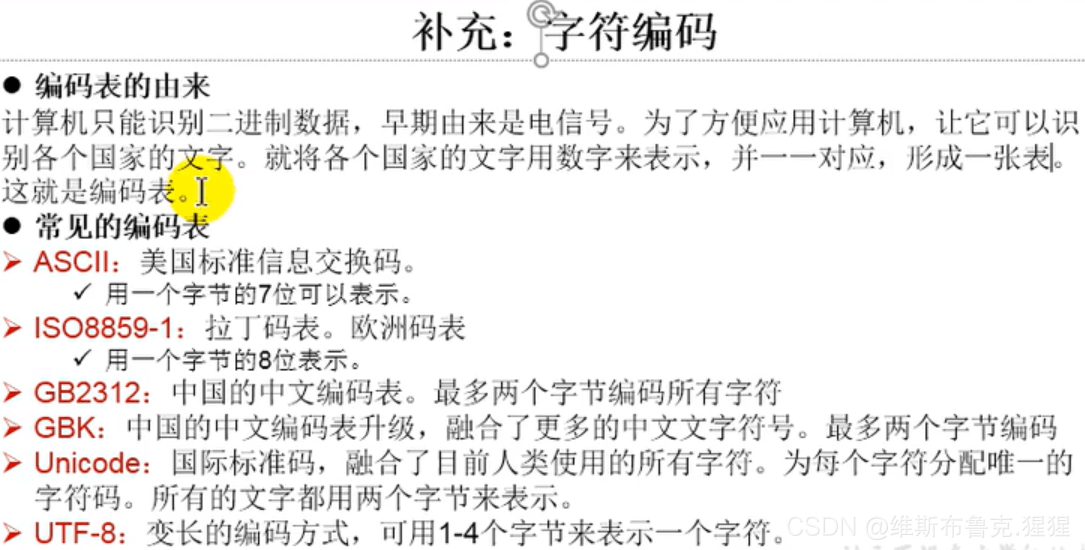
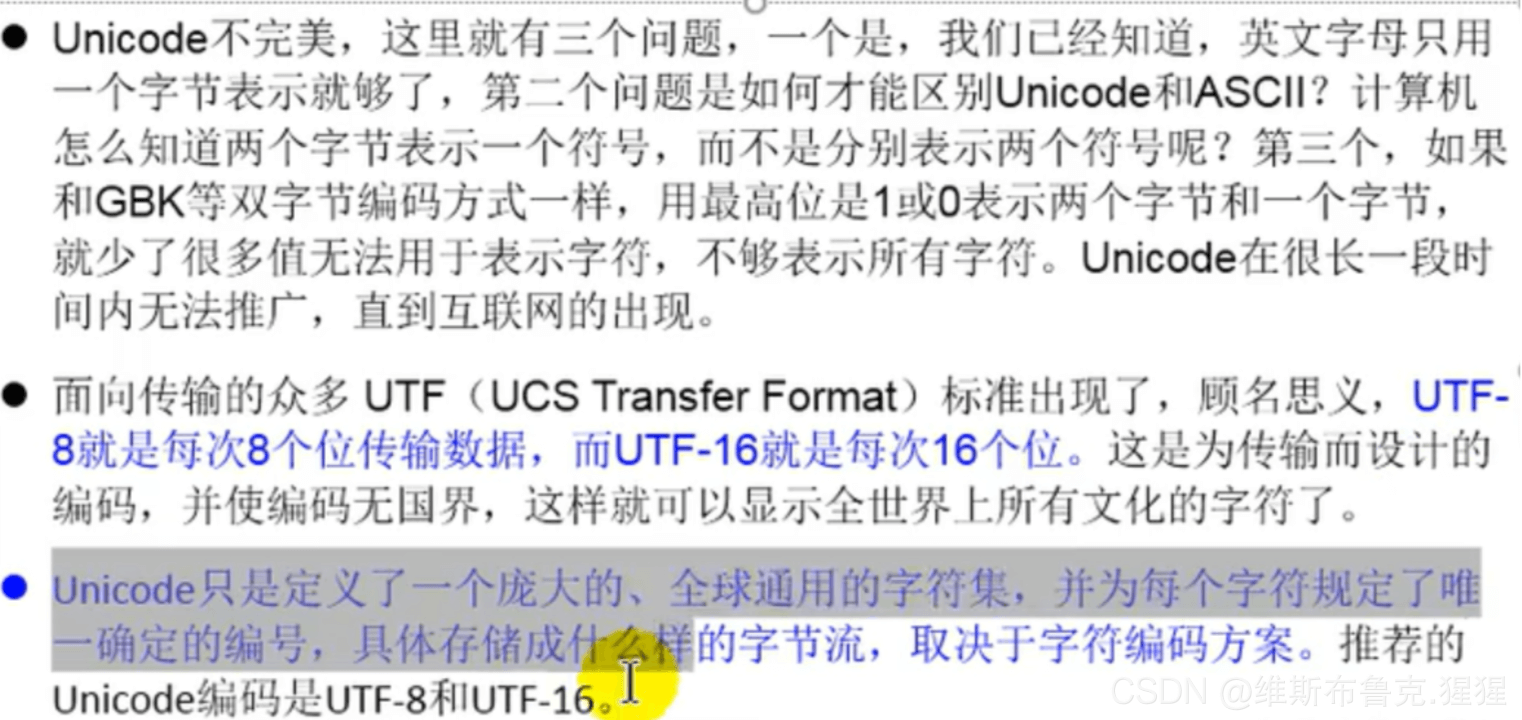
1.1System.in:標準的輸入流,默認從鍵盤輸入
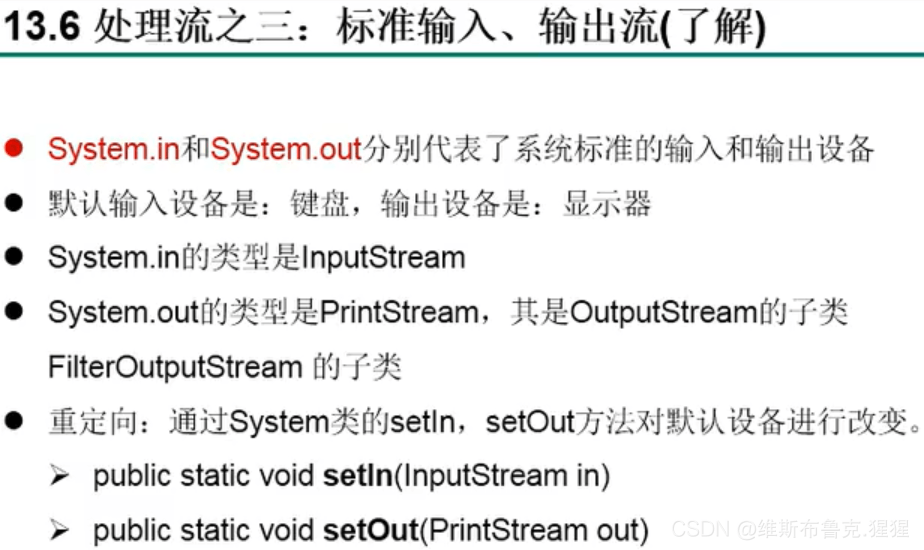
System.out:標準的輸入流,默認從控制臺輸出
1.2System類的setIn() / setOut()方式重新指定輸入和輸出的流。
修改默認的輸入和輸出行為:
System類的setIn(InputStream is) / setOut(PrintStream ps)方式重新指定輸入和輸出的流。
1.3練習:
從鍵盤輸入字符串,要求將讀取道德整行字符串轉換成大寫輸出。然后繼續進行輸入操作。
直至當輸入"e"或"exit"時,退出程序
方法一:使用Scanner實現,調用next()返回一個字符串
方法二:使用System.in實現。System.in ---> 轉換流 -->BufferedReader的readLine()
public static void main(String[] args) {
BufferedReader br = null;
try {
InputStreamReader isr = new InputStreamReader(System.in);
br = new BufferedReader(isr);
while(true){
System.out.println("請輸入字符串:");
String data = br.readLine();//調用此方法讀取一行數據
if("e".equalsIgnoreCase(data) || "exit".equalsIgnoreCase(data)){//避免空指針的寫法,之前有
System.out.println("程序結束");
break;
}
String upperCase = data.toUpperCase();
System.out.println(upperCase);
}
} catch (IOException e) {
e.printStackTrace();
} finally {
if(br != null){
try {
br.close();
} catch (IOException e) {
e.printStackTrace();
}
}
}
}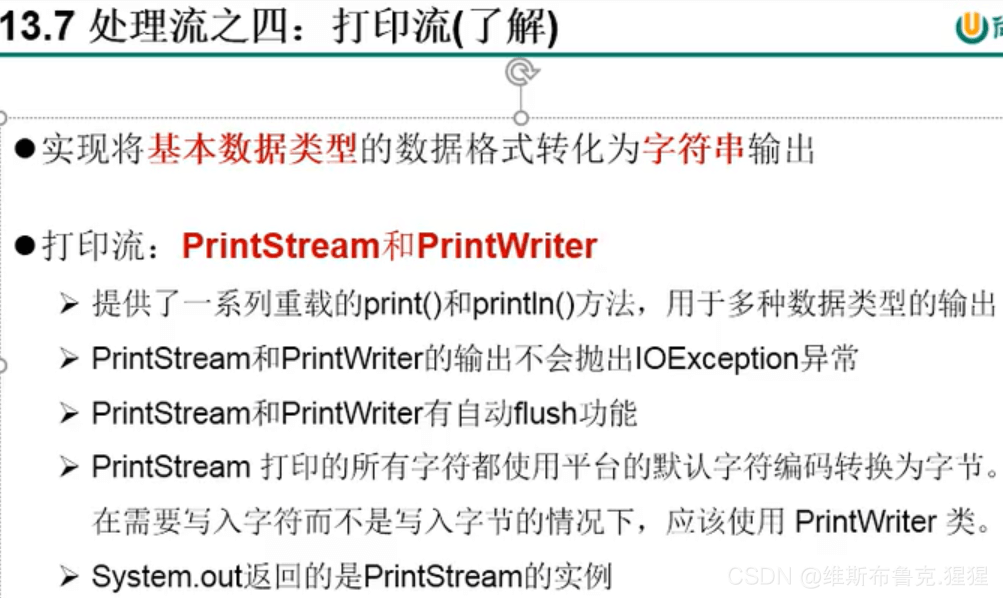
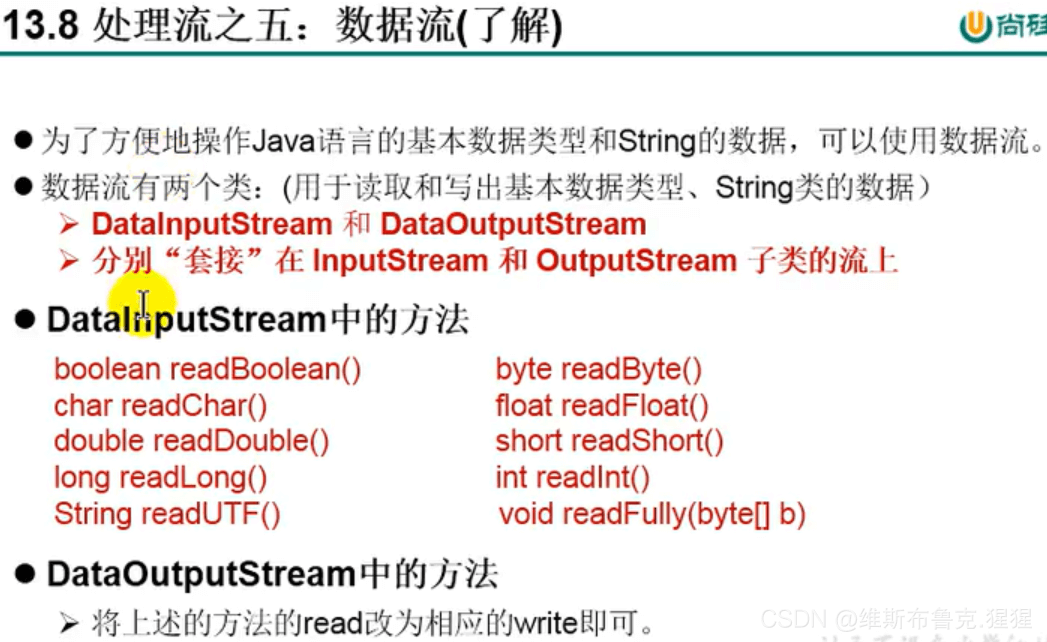
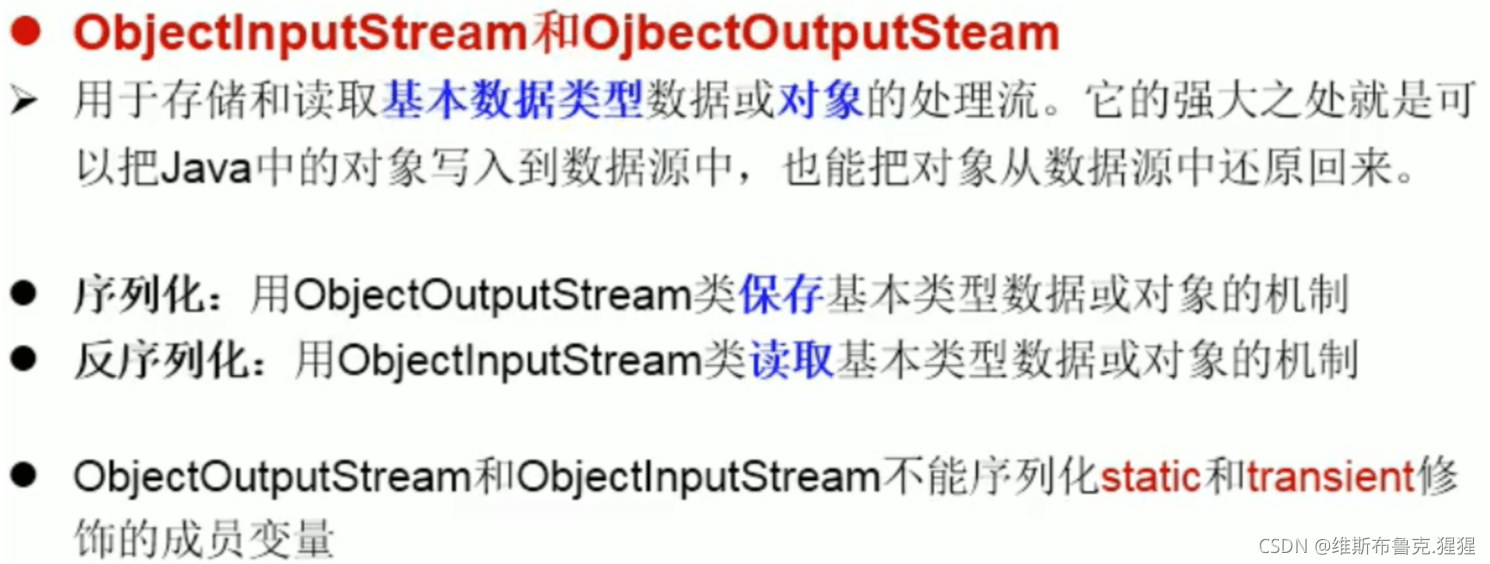
1.ObjectInputStream和ObjectOutputStream
2.作用:用于存儲和讀取基本數據類型或對象的處理流。
3.要想一個Java對象是可序列化的,需要滿足相應的要求。見Person.java
4.序列化機制:(重點!!!!)
對象序列化機制允許把內存中的Java對象轉換成平臺無關的二進制流,從而允許把這種二進制流持久的保存在磁盤上,或通過網絡將這種
二進制流傳輸到另一個網絡節點,當其他程序獲取了這種二進制流,就可以恢復成原來的Java對象
序列化過程:將內存中的java對象保存到磁盤中或通過網絡傳輸出去
使用ObjectOutputStream實現
@Test
public void testObjectOutputStream(){
ObjectOutputStream oos = null;
try {
oos = new ObjectOutputStream(new FileOutputStream("object.dat"));
oos.writeObject(new String("我愛北京天安門"));
oos.flush();//刷新操作
oos.writeObject(new Person("王銘",23));
oos.flush();
} catch (IOException e) {
e.printStackTrace();
} finally {
if(oos != null){
try {
oos.close();
} catch (IOException e) {
e.printStackTrace();
}
}
}
}
反序列化:將磁盤文件中的對象還原為內存中的一個Java對象
使用ObjectInputStream來實現
@Test
public void testObjectInputStream(){
ObjectInputStream ois = null;
try {
ois = new ObjectInputStream(new FileInputStream("object.dat"));
Object obj = ois.readObject();
String str = (String) obj;
Person p = ois.readObject();
System.out.println(str);
System.out.println(p);
}catch(IOException e){
e.printStackTrace();
}catch(ClassNotFoundException e){
e.printStackTrace();
}finally {
if(ois != null){
ois.close;
}
}
}Person需要滿足如下的要求,方可序列化
1.需要實現接口:Serializable
2.當前類提供一個全局常量:serialVersionUID
3.除了當前Person類需要實現Serializable接口之外,還必須保證其內部所有屬性也必須是可序列化的(默認情況下,基本數據類型、String:本身是可序列化的)
補充:ObjectOutputStream 和 ObjectInputStream不能序列化static和transient修飾的成員變量
eg:輸出結果:Person{name='null',age=0,id=0,acct=null}
public class Person implements Serializable{
public static final long serialVersionUID = 397497937034L;
private String name;
private int age;
@Override
public String toString() {
return "Person{" +
"name='" + name + '\'' +
", age=" + age +
'}';
}
public String getName() {
return name;
}
public void setName(String name) {
this.name = name;
}
public int getAge() {
return age;
}
public void setAge(int age) {
this.age = age;
}
public Person(String name, int age) {
this.name = name;
this.age = age;
}
public Person() {
}
}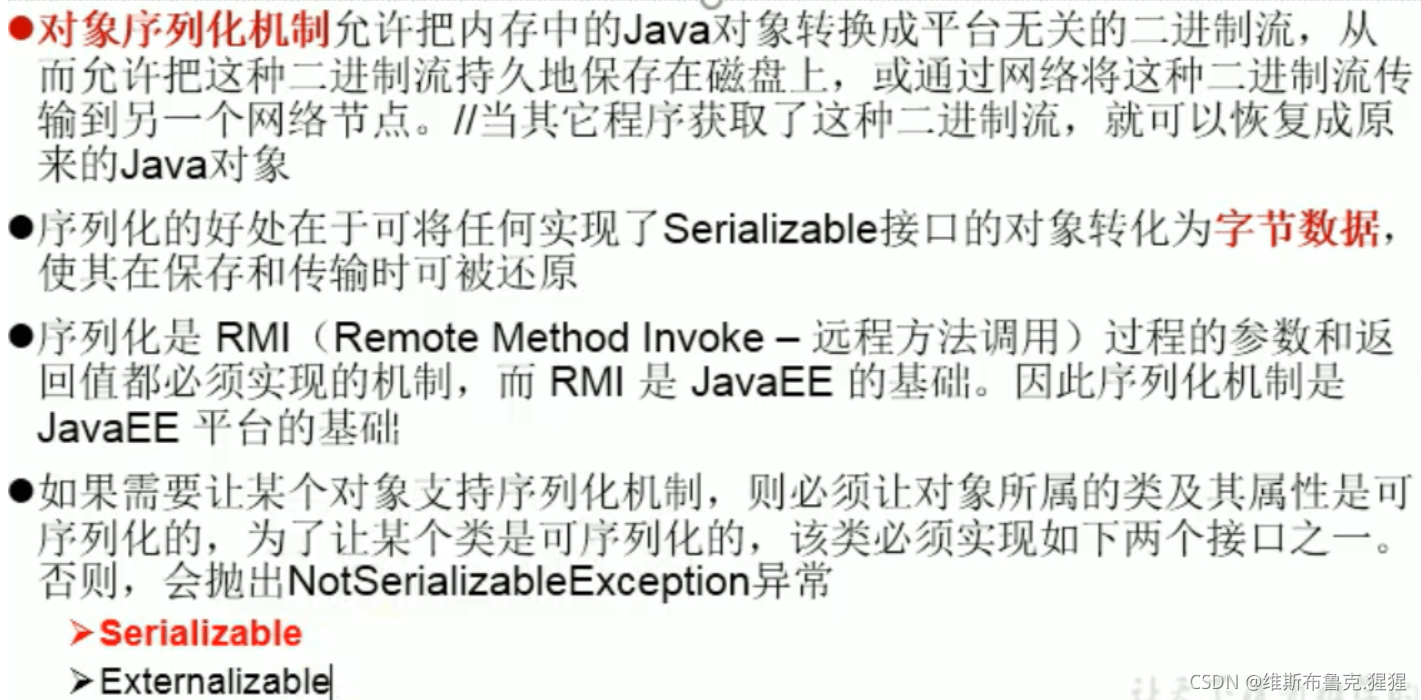
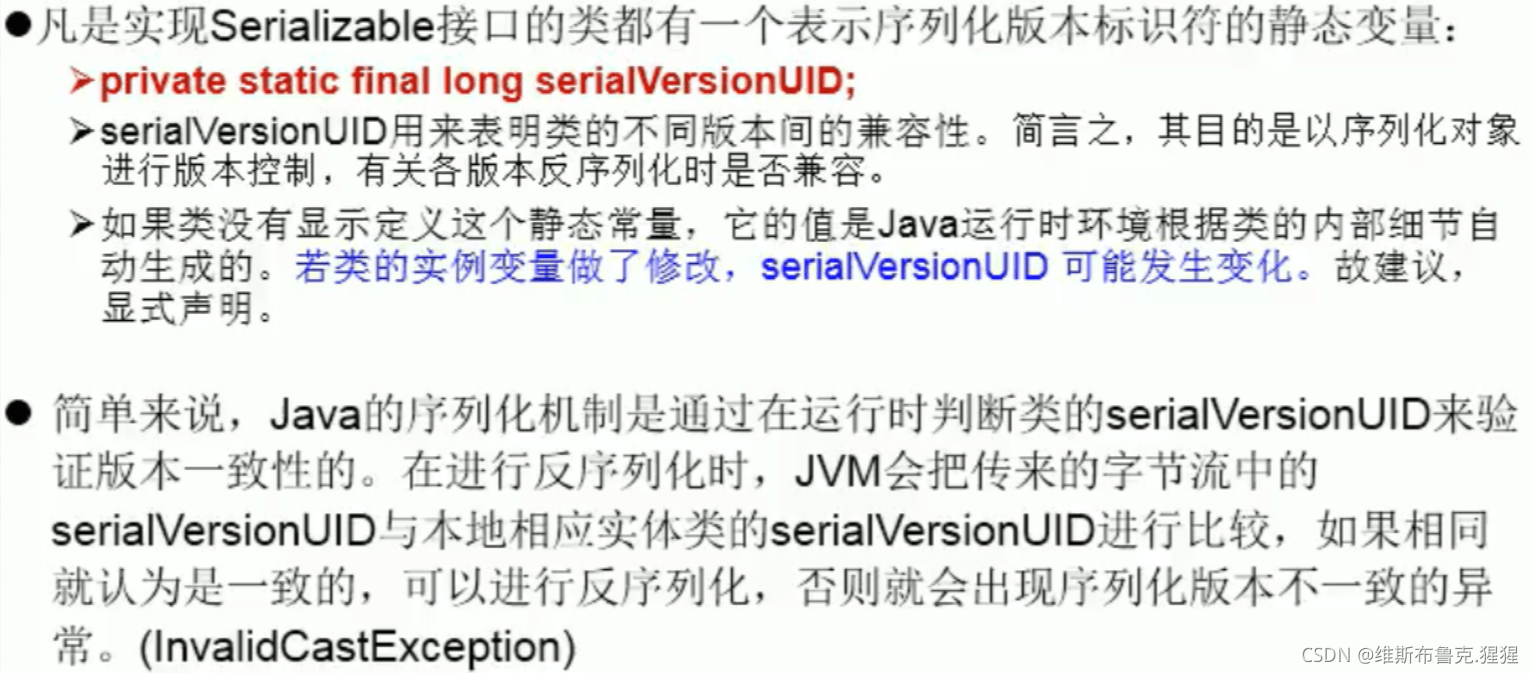
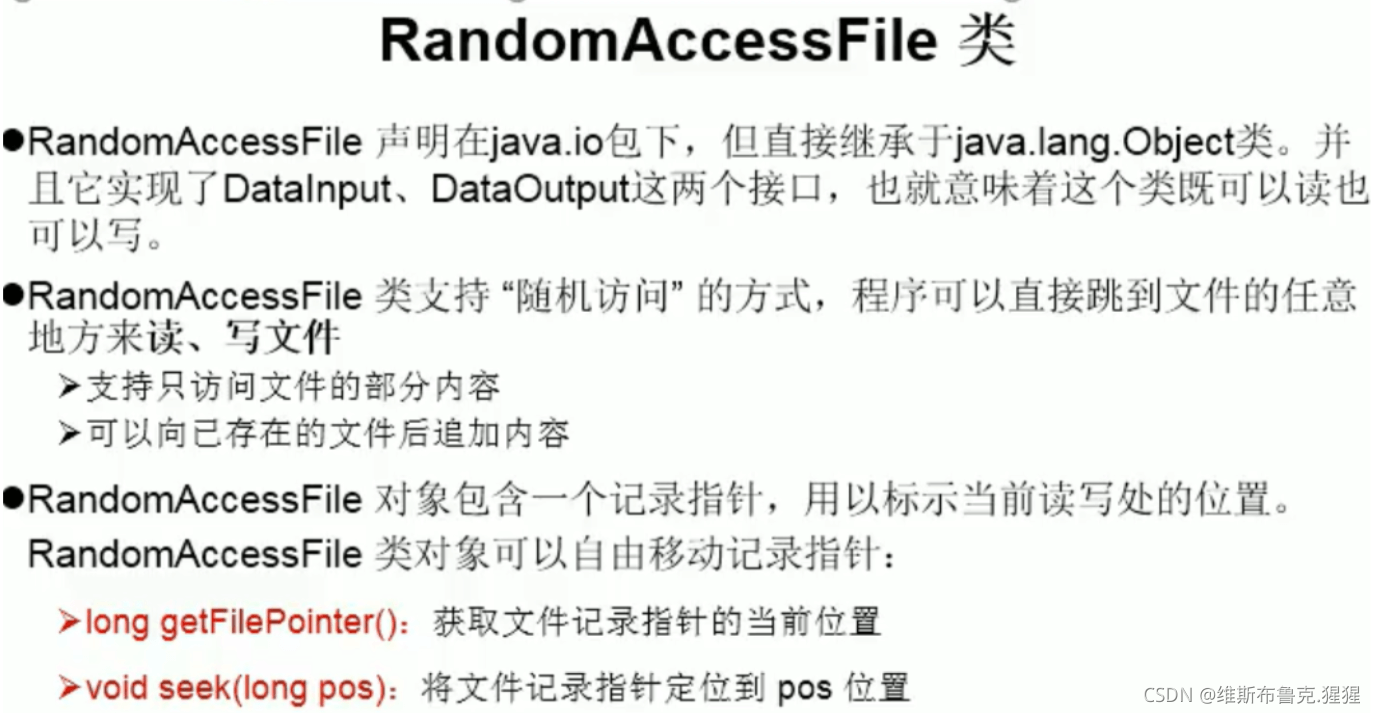
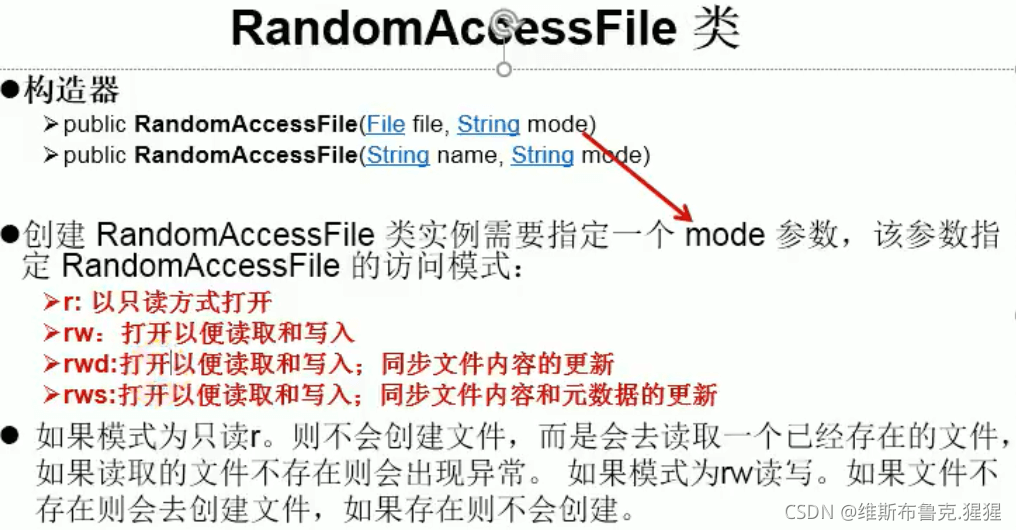
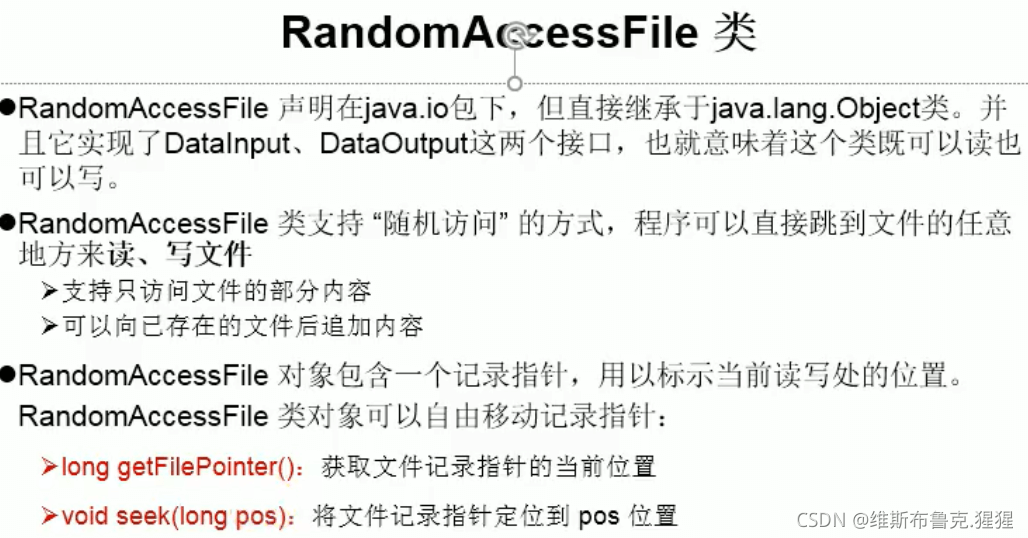
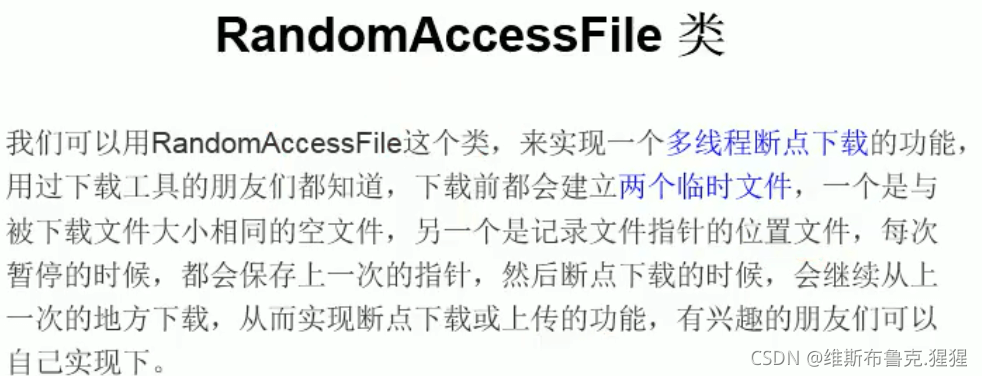
RandomAccessFile
1.RandomAccessFile直接繼承于java.lang.Object類,實現了DataInput和DataOutput接口
2.RandomAccessFile既可以作為一個輸入流,又可以作為一個輸出流
3.如果RandomAccessFile作為輸出流時,寫出到的文件如果不存在,則在執行過程中自動創建
如果寫出到的文件存在,則會對原有文件內容進行覆蓋,(默認情況下,從頭覆蓋)
4.可以通過相關的操作,實現RandomAccessFile"插入"數據的效果
public abstract class RandomAccessFileTest {
@Test
public void test1(){
RandomAccessFile raf1 = null;
RandomAccessFile raf2 = null;
try {
raf1 = new RandomAccessFile(new File("愛情與友情.jpg"), "r");
raf2 = new RandomAccessFile(new File("愛情與友情1.jpg"), "rw");
byte[] buffer = new byte[1024];
int len;
while((len = raf1.read(buffer)) != -1){
raf2.write(buffer,0,len);
}
} catch (IOException e) {
e.printStackTrace();
} finally {
if(raf1 != null){
try {
raf1.close();
} catch (IOException e) {
e.printStackTrace();
}
}
if(raf2 != null){
try {
raf2.close();
} catch (IOException e) {
e.printStackTrace();
}
}
}
}
@Test
public void test2()throws IOException{
RandomAccessFile raf1 = new RandomAccessFile("hello.txt","rw");
raf1.seek(3);//將指針調到角標為3的位置
raf1.write("xyz".getBytes());//
raf1.close();
}
使用RandomAccessFile實現數據的插入效果
@Test
public void test3() throws IOException{
RandomAccessFile raf1 = new RandomAccessFile("hello.txt", "rw");
raf1.seek(3);//將指針調到角標為3的位置
//保存指針3后面的所有數據到StringBuilder中
StringBuilder builder = new StringBuilder((int) new File("hello.txt".length()));
byte[] buffer = new byte[20];
int len;
while((len = raf1.read(buffer)) != -1){
builder.append(new String(buffer,0,len));
}
//調回指針,寫入"xyz"
raf1.seek(3);
raf1.write("xyz".getBytes());
//將StringBuilder中的數據寫入到文件中
raf1.write(builder.toString().getBytes());
raf1.close();
}
}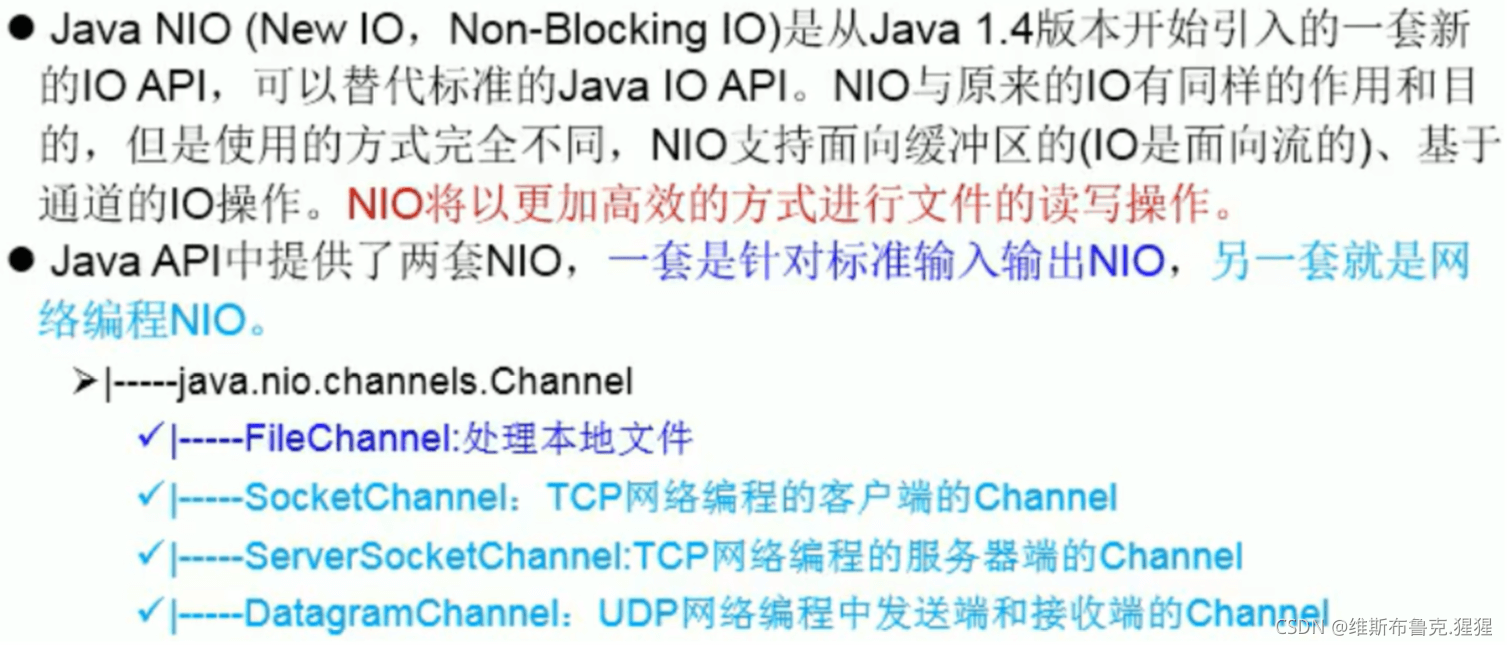
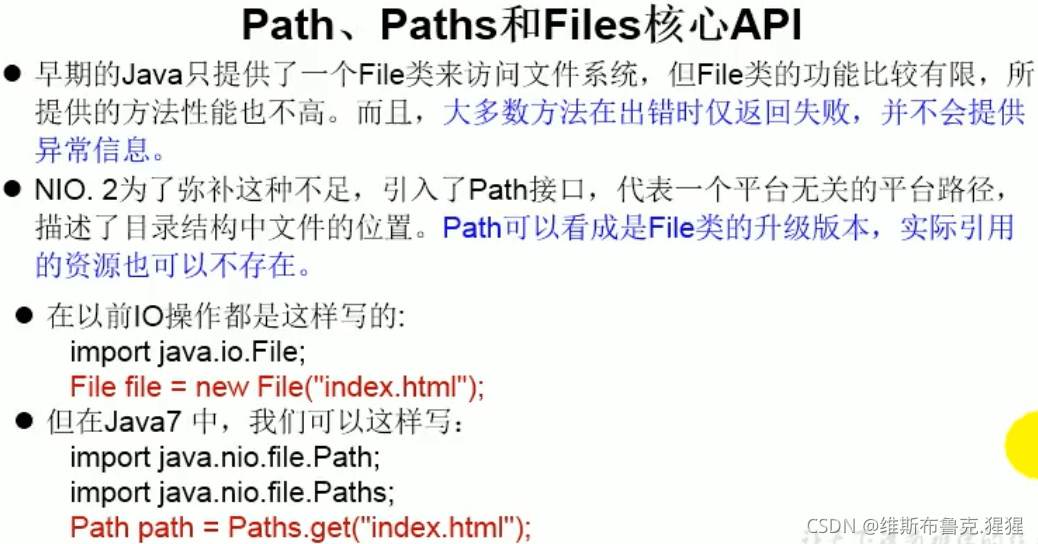
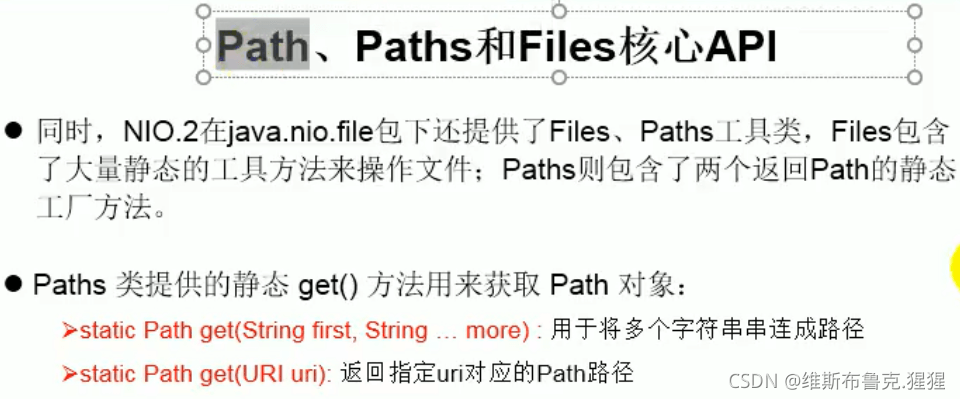
關于“Java中流怎么用”這篇文章就分享到這里了,希望以上內容可以對大家有一定的幫助,使各位可以學到更多知識,如果覺得文章不錯,請把它分享出去讓更多的人看到。
免責聲明:本站發布的內容(圖片、視頻和文字)以原創、轉載和分享為主,文章觀點不代表本網站立場,如果涉及侵權請聯系站長郵箱:is@yisu.com進行舉報,并提供相關證據,一經查實,將立刻刪除涉嫌侵權內容。